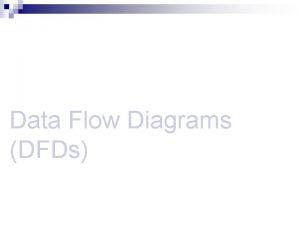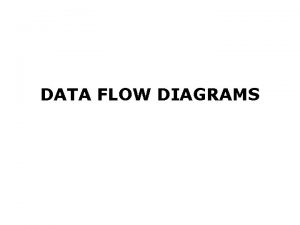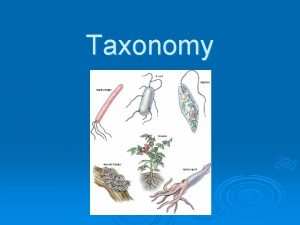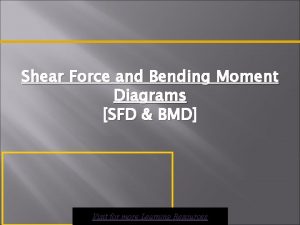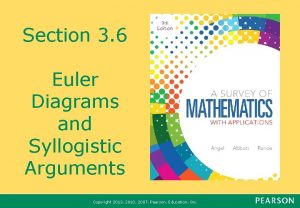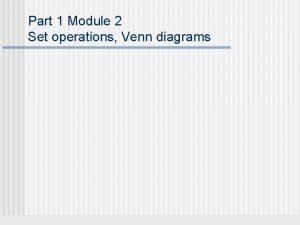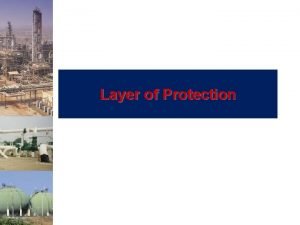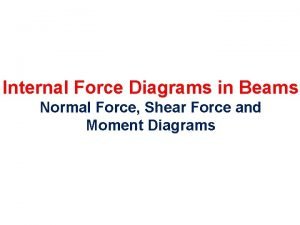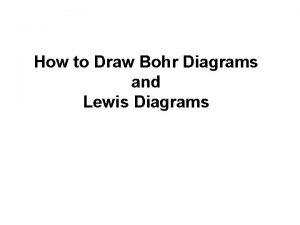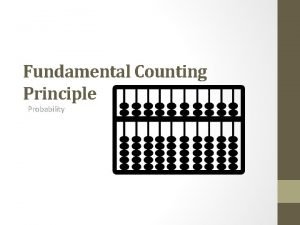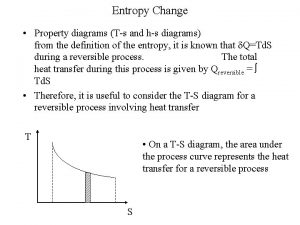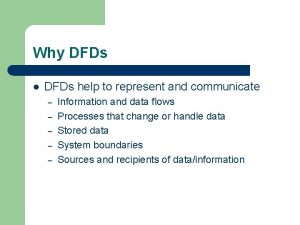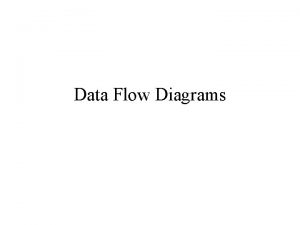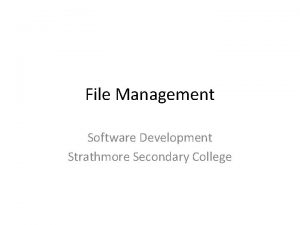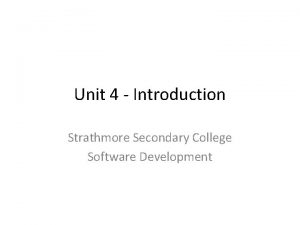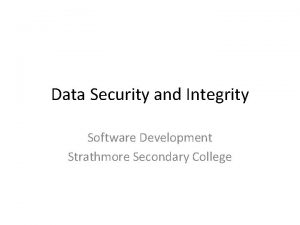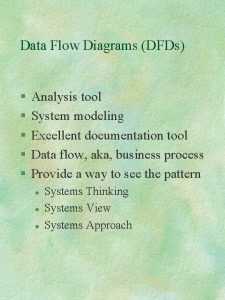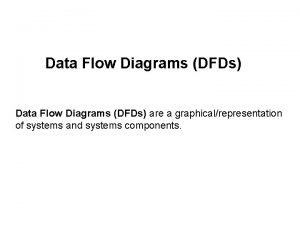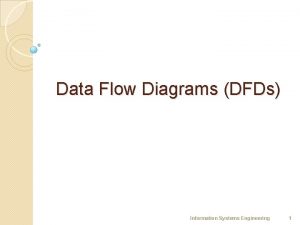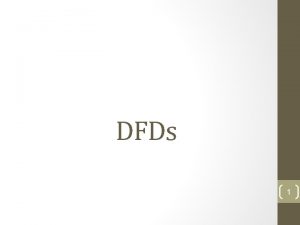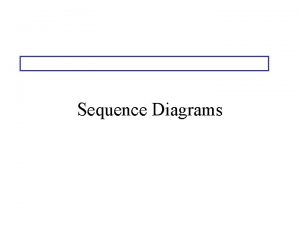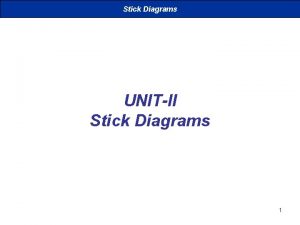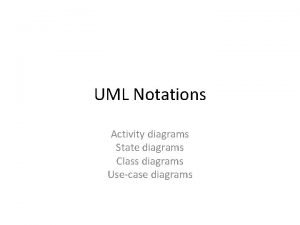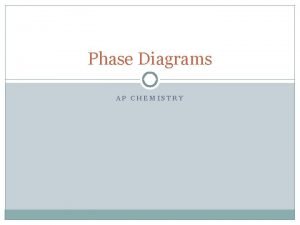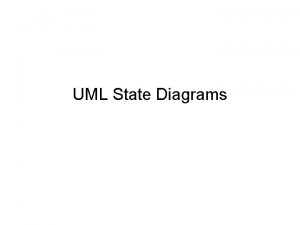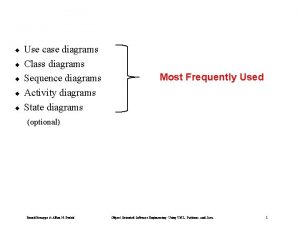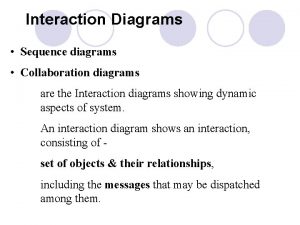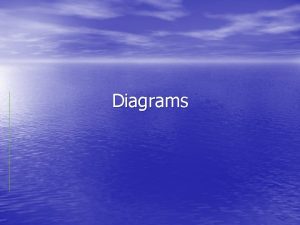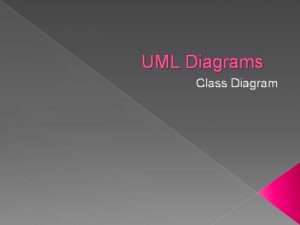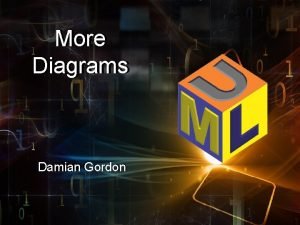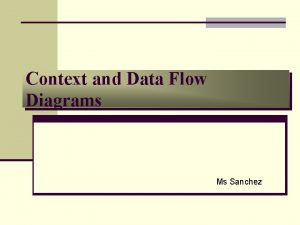Context Diagrams and DFDs Strathmore Secondary College 2015



























- Slides: 27

Context Diagrams and DFDs Strathmore Secondary College 2015

Data and Data Flow Analysis • Context and Data Flow Diagrams: – Main tools used to pictorially represent how application data and information flow through the system – Four symbols used: • • Process Interface Data Store Data Flow

Context Diagram Symbols

Context Diagram • Generally, does not show much detail – Very similar to a Use Case Diagram, but focuses on the input of data • Overview of the input from the outside world • Doesn’t show processing steps or storage procedures, just show processing within the system and the output from the system • Only data and information is supplied

DFDs • Data Flow Diagrams are a graphical way to represent the flow of data • They’re a more structured and scientific way of showing how a system works – it’s a visualisation of data processing within a system • This is different from a Flow Chart, which you should be familiar with from Year 11 – Flow charts are a graphical way to represent decisions and “control”. – DFDs represent “processes” and “transformations”

DFDs • Data flow diagrams are used to describe how the system transforms information. They define how information is processed and stored and identify how the information flows through the processes. • Use a Data Flow Diagram (DFD) to show the relationships among the business processes within an organization to: – external systems, – external organizations, – customers, – other business processes.

DFDs - Definitions • Process – An activity or function performed for a specific business reason – Manual or computerized • Data flow – A SINGLE PIECE of data or a logical collection of data – Always starts or ends at a process

DFDs - Definitions • Data Store – A collection of data that is stored in some way – Data flowing out is retrieved from the data store – Data flowing in updates or is added to the data store • External entity/interface – A person, organization, or system that is external to the system but interacts with it.


Using DFDs • Business processes are too complex to be shown on a single DFD • Decomposition is the process of representing the system in a hierarchy of DFD diagrams – Child diagrams show a portion of the parent diagram in greater detail • So, DFDs are created in layers – called LEVELS – Each level must be BALANCED – Balancing involves insuring that information presented at one level of a DFD is accurately represented in the next level DFD.

Sample DFD Level 0 – Context Diagram

Sample DFD

Relationship among Levels of DFDs Context diagram (Level 0) Level 1 diagram Level 2 diagram Level 3 diagram

DFDs • When building a data flow diagram, the following items should be considered: – where does the data that passes through the system come from and where does it go? – what happens to the data once it enters the system (i. e. , the inputs) and before it leaves the system (i. e. , the outputs)? – what delays occur between the inputs and outputs (i. e. , identifying the need for data stores)?

Drawing a DFD • Identify the BUSINESS PROCESSES to perform the work needed to generate the input and output data flows • Connect the data flows from the external entities to the processes. • Identify any data stores and draw them

Drawing a DFD • Connect the processes and data stores with data flows. • Check to make sure you’ve got all of the correct information showing • Continue to decompose to the nth level required DFD • Draw all DFDs at one level before moving to the next level.

Level 1 DFDs • Generally, one level 1 diagram is created for every major process on the level 0 diagram • Shows all the internal processes that comprise a single process on the level 0 diagram • Shows how information moves from and to each of these processes • If a parent process is decomposed into, for example, three child processes, these three child processes wholly and completely make up the parent process

Level 2 DFDs • Shows all processes that comprise a single process on the level 1 diagram • Shows how information moves from and to each of these processes • Level 2 diagrams may not be needed for all level 1 processes • Correctly numbering each process helps the user understand where the process fits into the overall system

Alternative Data Flows • Where a process can produce different data flows given different conditions • We show both data flows and use the process description to explain why they are alternatives • Tip -- alternative data flows often accompany processes with IF statements

Class Task • At this point in the process it is easy to lose track of the “big picture”. • Describe the difference between data flows, data stores, and processes. • Describe in your own words the relationship between the DFD and the ultimate new application being developed.

Process Descriptions • Text-based process descriptions provide more information about the process than the DFD alone • If the logic underlying the process is quite complex, more detail may be needed in the form of – Structured English – Decision trees – Decision tables

Layout Suggestions • Layouts typically place – processes in the center – inputs from the left – outputs to the right – stores beneath the processes

Sample DFD

At what level do you stop? • When to stop decomposing DFDs? – Ideally, a DFD has at least three processes and no more than seven to nine.

Validating a DFD • For each DFD: • Check each process for: – A unique name: action verb phrase; number; description – At least one input data flow – At least one output data flow – Output data flow names usually different than input data flow names – Between 3 and 7 processes per DFD

Validating a DFD • For each DFD: – Check each data flow for: • A unique name: noun; description • Connects to at least one process • Shown in only one direction (no two-headed arrows) • A minimum number of crossed lines – Check each data store for: • A unique name: noun; description • At least one input data flow • At least one output data flow – Check each external entity for: • A unique name: noun; description • At least one input or output data flow

Class Task • Draw a Context Diagram for a bank ATM – Ensure you consider all of the data required to: • Initiate Banking Processes • Check balances • Withdraw cash
 Dfd errors
Dfd errors Black hole dfd
Black hole dfd The interaction diagrams, use case diagrams are called as
The interaction diagrams, use case diagrams are called as Activity diagram if
Activity diagram if Social deixis examples
Social deixis examples High context vs low context culture ppt
High context vs low context culture ppt High context vs low context culture ppt
High context vs low context culture ppt Soal essay komunikasi verbal
Soal essay komunikasi verbal Gladstone park secondary college
Gladstone park secondary college Craigieburn secondary school
Craigieburn secondary school Mentone girls’ secondary college ranking
Mentone girls’ secondary college ranking Asd college college readiness program
Asd college college readiness program Early college high school at midland college
Early college high school at midland college Uml stands for
Uml stands for What five probable ancestors of the modern bird
What five probable ancestors of the modern bird Smd and bmd
Smd and bmd Euler diagram arguments
Euler diagram arguments Piping and instrumentation diagrams
Piping and instrumentation diagrams A-b shaded venn diagram
A-b shaded venn diagram Layers of protection
Layers of protection Shear and moment diagram examples
Shear and moment diagram examples Neon br diagram
Neon br diagram Fundamental counting principle tree diagram examples
Fundamental counting principle tree diagram examples Allppt.com
Allppt.com Alppt
Alppt Ts and hs diagrams
Ts and hs diagrams Aon aoa
Aon aoa Wiring
Wiring
